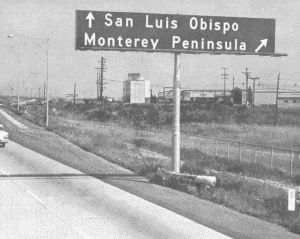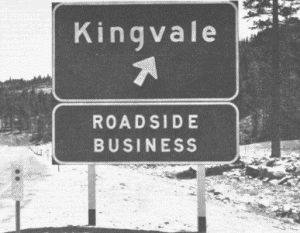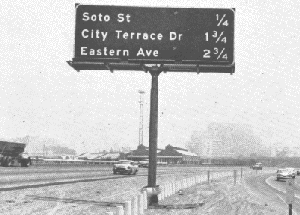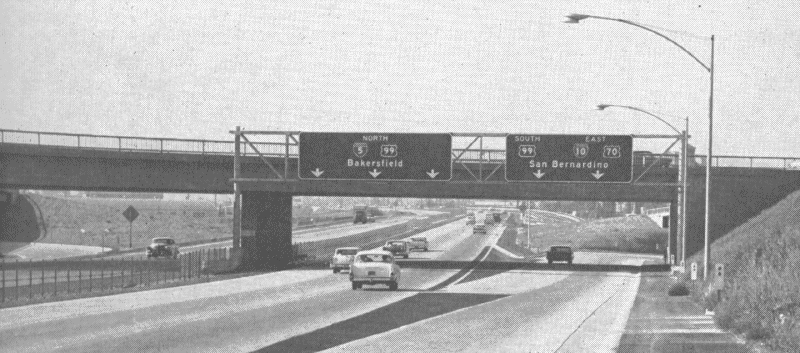
Example of an early Guide Sign. This is on US 101 in Salinas.

In the original State scheme, upcoming exit signs displayed distance in tenths of miles.
This is a recently completed (in the late 1950's) section of the Ventura Fwy. (US 101) in Encino.

Early exit signs used a down arrow over the exit instead of the upward diagonal one.
This also shows the early white-outline used for US shields.

Early style of Business district identification.

Sign cleaning in Los Angeles, about 1956.

This the later, MUTCD-conforming exit type, using diagonal arrow.

Modern upcoming exits sign. This sign is in lieu of postmile exit identification.

Early confusion led to the practice of identifying the thru route at major junctions.
Previously, motorists would see an exit for a bypassed community and prematurely exit the
freeway, thinking that the route continued into the city instead of bypassing it.
Some have noticed that California deviates from the rest of the nation in some of its interstate and freeway signing practices. These differences may stem from the fact that California led the nation in creating basic standards for signage on its emerging freeway and expressway system. Early guide signs were crude and usually specific to the particular location. However, in 1956, state highway engineers developed a number of specific guidelines for creating signs to be standardized across the state.
The overhead sign that is now typical of all interstates was first used in California along heavily travelled urban freeway segments, and as of 1956 the Golden State was using overhead signing more extensively than any other state. Another California innovation was the use of white lettering on a black background, which enhanced visibility and legibility. Vestiges of these antique signs can still be found, most notably the black sign along Northbound Interstate 5 at the I-210/CA 14 truck route separation. Due to its success in California, this light-on-dark scheme was later incorporated for use in Interstate guide signs (using Green instead of Black) into the Manual on Uniform Traffic Control Devices (MUTCD), which specifies signage requirements for the Interstate (and Federal ?) System.
Additional California innovations included the use of capital and lower case lettering for guide signs, which was adopted on many eastern toll roads and also made its way into the interstate system, the use of auxillary sign illumination, and the inclusion of worker catwalks and handrails for cleaning and maintenance. California may have also independently come up with the idea of identifying bypassed business districts with their "Roadside Business" signs and their substandard "Route X Freeway/Business" designations. The California practice is different from the Interstate Practice of labelling Business and Loop Routes.
Guide sign placement was first standardized in the "Standard Plans for Overhead Sign Structures" in 1957. It specified advance warning of exits along urban routes with distance (in tenths of miles instead of quarters) and multiple exit notifications. Advance was given by locating an overhead sign before the exit giving the exit name and using a down arrow above the right lane to notify drivers which lane to merge into. At the exit gore, a T-type sign (called a butterfly sign) gives the exit on the right (over the ramp) with a down arrow pointing down on the lane, and the next exit name on the left, again using a down arrow over the rightmost thru-traffic lane.
It is interesting to note that just as California developed this standard for the state, the Interstate standard was set in place. Many of the ideas tried in California were used for the national system with some notable differences including the use of green instead of black, the use of white borders with rounded edges, and the use of lower case lettering for destination only. Also, the use of the upward diagonal arrow at exits was a national standard not included in the original California plan; CA used a down arrow instead. Down arrows were permitted at freeway-to-freeway connector exits. And, a clause in the national standard requiring shields on overhead guide signs to be in their official coloring forced California to change from their white outline US shields to the all-white shields found today. This may also explain the rare occurrence of a white state route shield on guide signs (such as appears on the eastbound Ventura Fwy. east of US 101, on the CA 170 portion of the southbound Hollywood Fwy. north of CA 134, and on the connector from southbound US 101 to eastbound CA 37 in Novato). California state routes used to be white, and the guide sign standard may have been imposed prior to the state route changeover from white to green. Thus just as California was becoming a leader in sign standards, it was already deviant from the national standard. This independence continues today; California does not conform to the national standards in some areas and still uses many of its own ideas. In fact, California’s trademark dark green instead of the national standard of light reflective green may be a subtle method of preserving its original, trademark black overheads that pioneered signing practice in the nation.
So, while California may be an oddity with some of its signing practices, keep in mind that this autonomy is somewhat justified; California was an innovator in sign practices and contributed much to the final form of the present interstate system.
 First "modern" California style guide sign. Green background, lower case
destination lettering, interstate co-signing, down arrows for thru traffic and freeway-
to-freeway connectors. The white US shields still hadn't been implemented though. This
was approximately 1960 at the Golden State/San Bernardino Fwy split.
First "modern" California style guide sign. Green background, lower case
destination lettering, interstate co-signing, down arrows for thru traffic and freeway-
to-freeway connectors. The white US shields still hadn't been implemented though. This
was approximately 1960 at the Golden State/San Bernardino Fwy split.